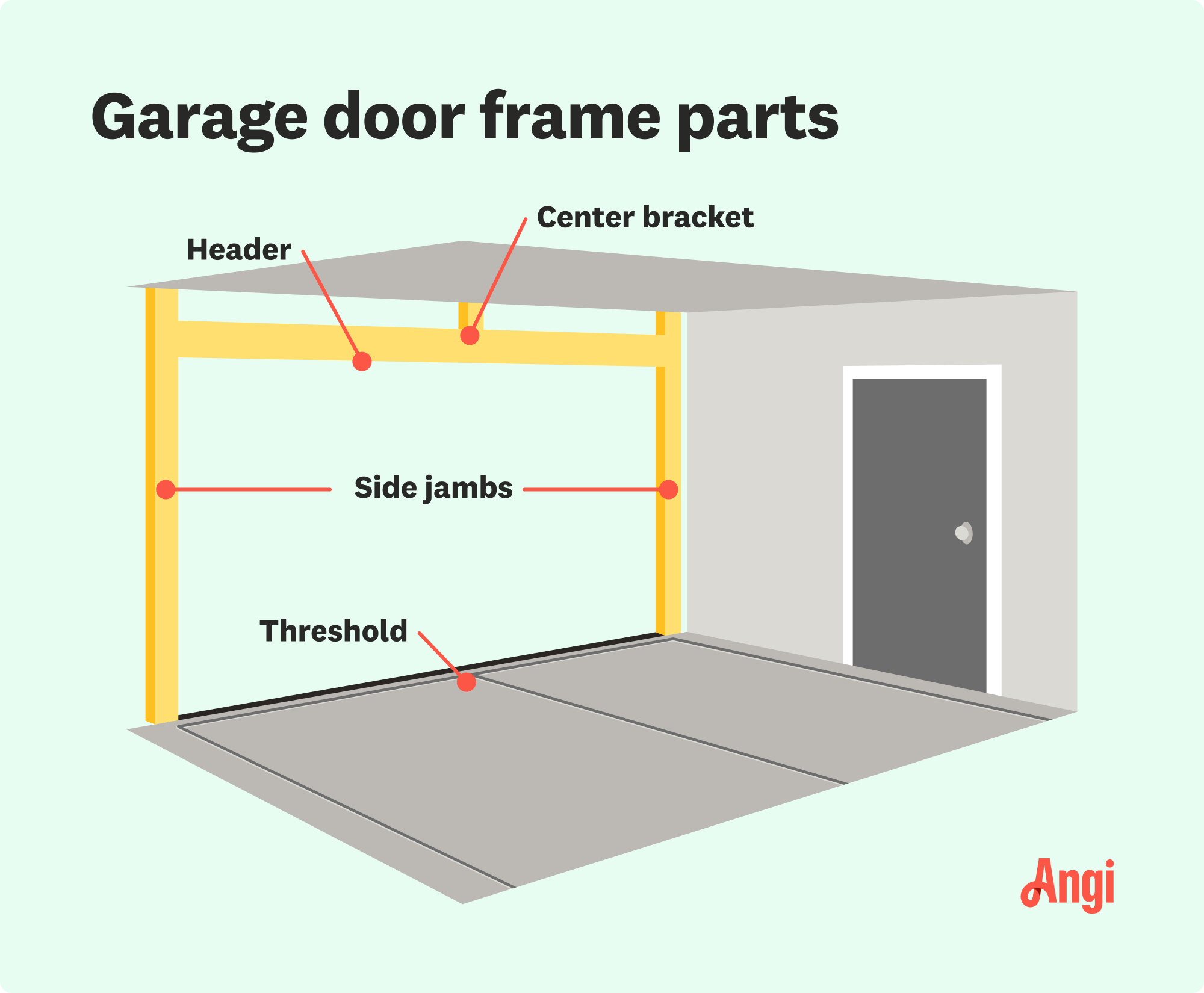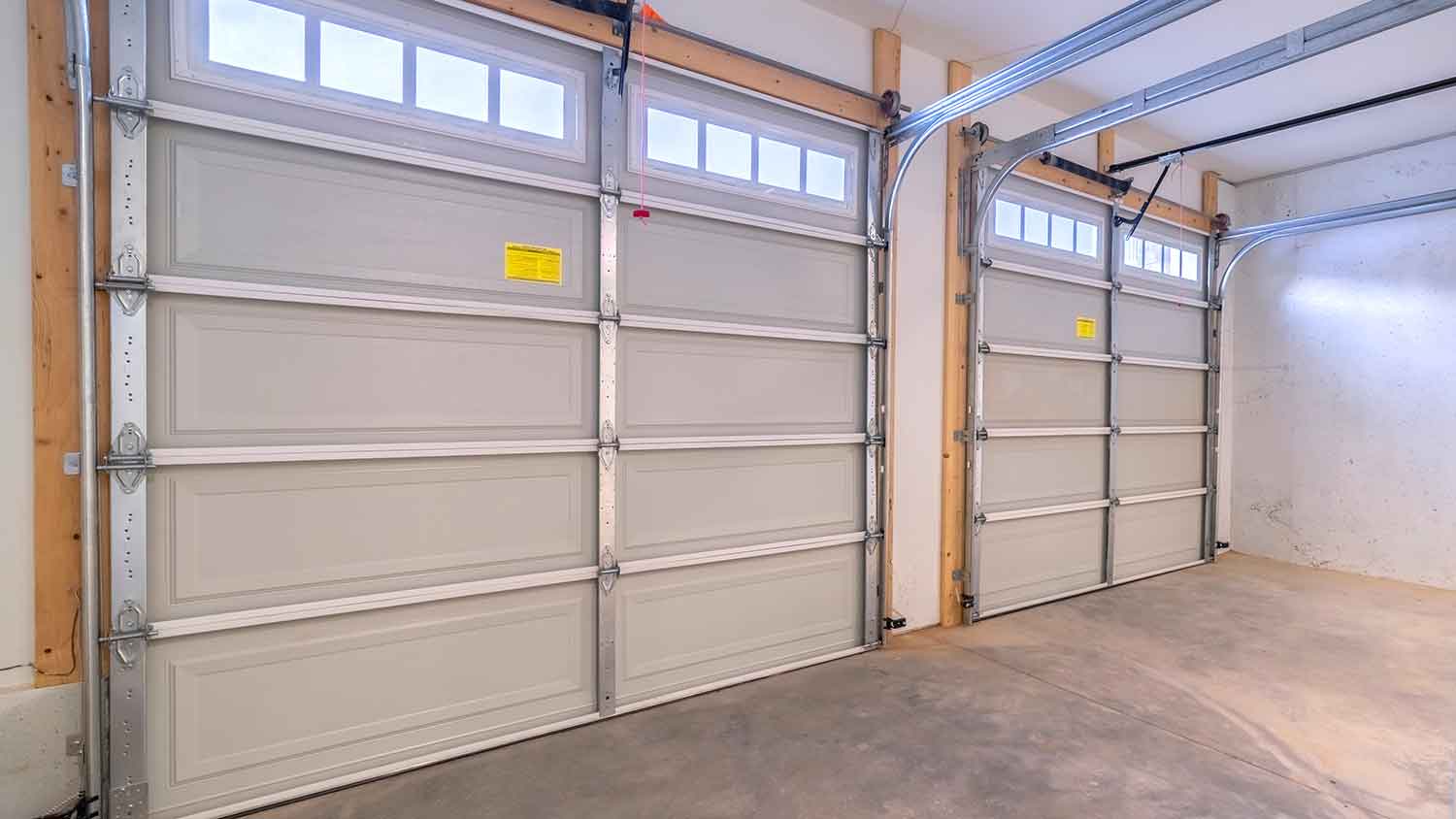
The cost to build a carport can range from $3,072 to $9,435, depending on the size, materials, and type of carport. Keep reading to learn about carport costs.
Your garage door can't hang without it


A garage door frame provides structural support and guides the door’s movement.
Engineered wood, steel, and aluminum are the most common garage door framing materials.
Fixing a garage door frame is best handled by a garage repair professional.
At the heart of a strong and efficient garage door system lies its frame, a structural assembly composed of essential parts that let the door operate smoothly. Your garage door framing diagram includes pivotal measuring guidelines to help you understand your garage door frame. From the frame’s specific parts, to its maintenance and the cost to repair or replace a garage door frame—the diagram sheds light on what you need to know.

The garage door frame provides structural support and stability for the entire garage door system. The frame distributes the weight of the door evenly and prevents stress on components. Essential elements such as tracks and springs are affixed to the frame to facilitate smooth and controlled door movement. The frame also contributes to the garage's weather resistance, sealing and protecting the space from the elements.
Garage door framing material varies, but engineered wood, steel, and aluminum are the most common materials.
The header of a garage door frame is positioned horizontally at the top of the door opening. The primary function of the header, sometimes referred to as a head jamb, is to bear the weight of the garage door, distributing it evenly to ensure proper support for the door as it moves along its tracks.
The header's dimensions are crucial to the structural integrity of the frame. The exact measurements for how to frame a garage door are determined by the size and type of the door. It’s a common practice to have the header measure 9 inches longer than the length of the garage doors.
For example, given one of the standard garage door sizes, a single-car door is 8 to 9 feet wide, the header should be between 8 3/4 and 9 3/4 feet wide. The height of the header should be 1 1/2 inches taller than the door height. When buying a garage door, it's essential to factor in your garage space measurements to ensure your choice will make a good fit.
The jambs are vertical components of a garage door frame located on each side of the door opening. Their primary function is to provide vertical support to the garage door, guiding its movement during the opening and closing process. Jambs serve as attachment points for various components, including hinges and tracks, contributing to the stability and alignment of the door.
The top of the jambs touch the bottom of the headers but should not touch the garage floor. To account for this gap, the side jambs should be 1/4 inch less than the height of the garage door. For example, the average height of a garage door is between 7 and 8 feet or 84 and 96 inches, so the jambs would have to measure 83 3⁄4 and 95 3/4 inches in height.
A bracket is affixed at the center of the header This piece is made of the same material as the header and jambs. While the size is often the distance from the top of the header to the ceiling, it may vary based on the type of garage door you install. Your local garage door builder will attach the door's spring system center bracket to this piece of framing.
The threshold of a garage door frame is a horizontal component located at the bottom of the door opening to create a seal along the bottom edge of the garage door. This barrier protects against external elements such as water, debris, insects, and drafts. Using a threshold is optional and may not be required if the garage door makes an efficient seal against the floor.
The threshold should be the length of the garage door opening from one end of the opening to the other. When purchasing a threshold, it's helpful to buy a size slightly bigger than your opening and then cut it to size.
Maintaining the parts of a garage door frame is crucial for ensuring the smooth and efficient operation of the entire garage door system. Regularly inspect all components and clean them as necessary. Identifying signs of wear or damage will vary based on the material of the garage door frame, but you should always look for rust, rot, or warping.
As most of the components of the garage door will be attached to the frame, you'll want to check around these fixtures to ensure they are still secure. For the threshold, this part will likely require regular cleaning to remove any built-up dirt and debris. Check for signs of damage as well.

Of all the garage door frame repairs, most savvy homeowners could easily complete threshold repair. Cleaning and replacing a threshold doesn't require a lot of skill or heavy lifting. Replacing the threshold would require the cost of materials ranging between $40 and $100 on average.
However, for any other damage to the garage door frame, hiring a garage door repair technician would be your best course of action. The frame is the base of the entire garage door system and if the frame is damaged, repairs may be quite intensive. The skillset required to dismantle the garage door to access parts of the frame requires professional-level expertise that most homeowners may not have.
Depending on the extent of the damage to your frame, the average garage door repair cost ranges between $80 and $700. When hiring a professional, you can rest assured the job will be completely safe and leave little room for error. Attempting to DIY garage door frame repair could result in more costly repairs should any mistakes occur.
The extent of the damage and age of the frame will help homeowners determine whether repairing or replacing a garage door frame is the best option. If the damage is minimal, such as surface scratches or minor dents, a repair can be a viable and cost-efficient solution. Simple maintenance tasks, like lubricating components, can often address common issues and extend the life span of the existing frame.
However, for extensive damage, such as structural issues with the header or severe warping of the jambs, replacement may be the more prudent choice. Signs of significant wear, rot, or damage that compromise the frame's integrity may warrant a complete replacement for safety and long-term durability. If the frame is outdated or lacks the necessary structural support for a heavier or modern garage door, replacement may be necessary to accommodate newer door models.
From average costs to expert advice, get all the answers you need to get your job done.

The cost to build a carport can range from $3,072 to $9,435, depending on the size, materials, and type of carport. Keep reading to learn about carport costs.
A garage extension is a great way to add space for work, hobbies, and storage. Learn how much a garage extension costs so you can budget accordingly.

Considering enclosing your carport to turn it into a more protective garage? Find out about the cost to convert a carport into a garage in this handy guide.

If you need to build extra living space at your home, this guide on how to convert a garage into a bedroom shows you all the steps.

If you’ve ever wondered, “Who can I get to build a carport?” you’re in the right place. Read on to learn about professional carport builders.

You may wonder, "Who do I hire to install an electric garage heater?" Use our advice to find the right professional to install your garage heater safely.